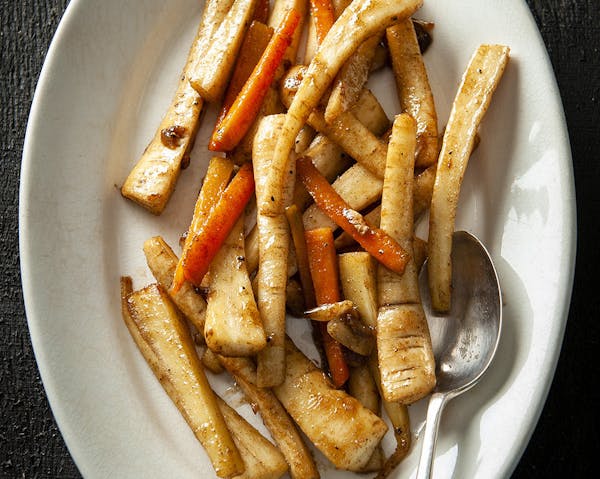I didn't grow up eating parsnips, so the first time I tasted them — pan-roasted and glazed with chile spike — I was hooked. They looked exotic, like a carrot crossed with a chestnut, slightly nutty, earthy and sweet.
Parsnips are seriously underrated and overlooked. The humble prize of our winter gardens, parsnips are harvested in the late fall or overwintered and then plucked from the thawing ground come spring. Once parsnips experience frost, they become sweeter as the stored starches in the root are broken down and converted to sugar. This is actually the parsnips' defense against the cold weather because the sugar molecules make the water in the plant cells less likely to freeze.
Find local parsnips at the farmers market or co-op, looking for thin- and medium-size firm roots, and avoiding any that are shriveled or deeply nicked. Avoid the big, fat roots, which tend to be woody and fibrous. Parsnips are a great storage crop. When you get them home, wrap them in a damp towel and store in the crisper drawer of the refrigerator, where they will stay fresh for at least two weeks.
The British are ever so fond of their parsnips: mashing them with potatoes to serve alongside beef tenderloin, or simmering them into rich, creamy bisques. These frugal roots are deceptively luxurious when paired with duck confit or slow-roasted leg of lamb. Baked in a slow oven with cream and warm spices (cumin, coriander, nutmeg), parsnips make a cozy dinner with a side of sautéed bitter greens, pure comfort on a cold, weary winter night.
If you find yourself with a thick parsnip, you may need to remove the fibrous core. First cut the root into quarters lengthwise, then slice the core with a sharp knife. Once cut, parsnips do tend to oxidize, so if you are preparing them well in advance, hold the cut pieces in acidulated water with vinegar or lemon juice.
Parsnips grow prolifically in northern regions and pair nicely with other root vegetables, especially carrots. When simply roasted in a pan on the stove or in the oven, the root's sweet nature becomes more of itself as it caramelizes to a lush toasty brown. You can season roasted parsnips with savory herbs such as rosemary, sage and/or thyme, or a dollop of horseradish cream. With a lick of maple syrup or honey, those parsnips shine. Just a drizzle is all that it takes.
Beth Dooley is the author of "In Winter's Kitchen." Find her at bethdooleyskitchen.com.
Ukrainian duo heads to the Eurovision Song Contest with a message: We're still here
With 'Alien' back in theaters, 'Alien: Romulus' director teases how the new film connects
Here's why Harvey Weinstein's New York rape conviction was tossed and what happens next

